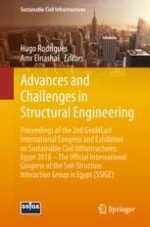2019 | Buch
Advances and Challenges in Structural Engineering
Proceedings of the 2nd GeoMEast International Congress and Exhibition on Sustainable Civil Infrastructures, Egypt 2018 – The Official International Congress of the Soil-Structure Interaction Group in Egypt (SSIGE)
herausgegeben von: Ph.D. Hugo Rodrigues, Prof. Amr Elnashai
Verlag: Springer International Publishing
Buchreihe : Sustainable Civil Infrastructures
